The Shores of Tripoli: A Strategy Game by Kevin Bertram (Fort Circle Games: Washington, DC)
Recently I was fortunate to be asked to review a game about the Barbary Pirates who caused a considerable amount of trouble for Thomas Jefferson and the naval forces of the young United States. The game, The Shores of Tripoli, is the first game put out by the new gaming company, Fort Circle Games. Kevin Bertram, the game’s designer, is already making a name for himself with this interesting competitive portrayal of the first overseas “war” that the United States found itself involved in.
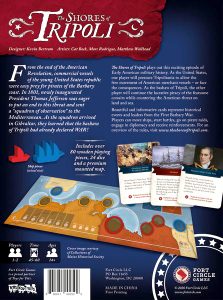
When the game box arrived at my home, I was amazed with the quality of the work before even opening it. The painting on the cover is of an American frigate doing battle. The red and blue colors are bold, with the title of the game emblazoned in white in the middle. I excitedly removed the cover and started taking the components out. The box included two decks of cards (one with Thomas Jefferson’s face and the other with the face of Yusuf Qaramanli, the Pasha and Bey of Tripoli), a beautifully designed game board showing the coast of north Africa, twenty-four colored dice, twelve gold coins (tokens), infantry blocks, time markers, and red, yellow, and blue small ships (corsairs, gunboats, frigates). There are two booklets: “Historical Supplement & Designer’s Notes” and “Rules of the Game.” And finally, as an added touch, the game includes a copy of a letter (on pseudo-parchment) from Jefferson to the Bashaw of Tripoli, asking for peace but warning that the US would protect its sailors. The letter has no effect on the playing of the game, but it adds to the drama and anticipated excitement of playing. Just having it nearby helps to create the desired “mood.”
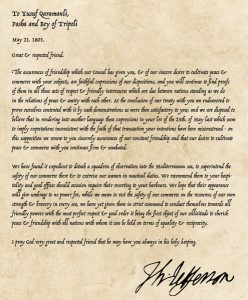
The “Historical Supplement & Designer’s Notes” describes the historical events of the First Barbary War, 1801-1805. The account is written by Dr. Abby Mullen, a professor at George Mason University and whose doctoral dissertation was about the First Barbary War. The images in this section are the same that appear on the playing cards used in the game. Kevin Bertram then explains how and why he came up with the game in the first place. He had read Thomas Jefferson and the Barbary Pirates, by Brian Kilmeade and Don Yaeger, and became fascinated by the First Barbary War. He wanted to present American history in an interesting and unique way by creating an hour-long card game. There were certain events that he wanted to cover in detail (piracy, the partnership with neutral Sweden, the Barbary alliances, the treaty of peace) and individuals who had to make their appearance (Hamet and Yusuf Qaramanli, William Easton, Stephen Decatur, Commodore Edward Preble, etc.). But the challenge was creating situations that could be played out within twenty-four turns each for two players. And although the war ended in 1805, Bertram’s game allows for play to continue into 1806. A brief bibliography is included for player who might be interested in finding out more about the conflict.
The next booklet to read through was the “Rules of the Game.” An inventory of all the game pieces is illustrated, so it is important to open each bag and count them all. The game map, or rather the game board, and how to use it during play is described. Each separate game piece is also explained, including the types of playing cards that will be used. The rules then continue for a total of eight pages. Now, I am not a gaming person because my older brother got that particular gene, but I was appreciative of the fact that the rules were simple and very explicit. Still, for me it was a daunting task to read through the many steps and guidelines. Each situation is accounted for, so having the rules handy during the first few times one plays the game is going to be crucial. Basic strategy is explained, and Bertram offers the helpful hint that play is better when one is eating at his favorite Nepalese restaurant.
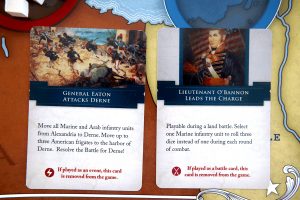
Although the game is for two players, rules are included if one wants to play solo. When that happens, the player has to take the American forces and go up against the “Tripolitan-bot,” referred to as the T-bot. A step-by-step summary is given for this situation because the options are a little different. The American forces play by the same rules as if it was a two-player game, but the Tripolitan forces have pre-determined actions to take.
The overall goal of the game depends on which side one is on. If one is playing the American side, then winning means that either the city of Tripoli is captured and the brother of Yusuf Qaramanli is installed as Bashaw, who will then approve a pro-American treaty. The Tripolitan side wins if either most of the American frigates are destroyed or all the gold tokens are taken from the Americans. Turns by each side are based on six years of four seasons each, so both players get four turns per year. This makes for a fast-paced game, lasting under an hour. When a player plays a card, there are options which differ depending on whether that player is playing the Americans or the Tripolitans. No matter how difficult the situation is by the end of the year, a new year allows for more chances to create other opportunities for victory. Although strategy is important, the roll of the dice in battle situations leaves a great deal to chance. For example, if all the American frigates are blockading Tripoli, the dice may still determine total defeat for them. It is possible for the game to end before the six years are up, and it is also quite possible for the game to end in a tie.
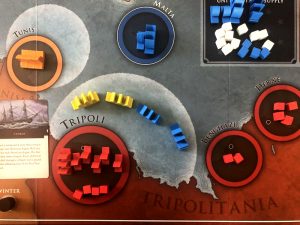
As I have mentioned previously, I am not a gamer. The first time I tried to play the game took well over an hour because the rule book was my constant companion. Luckily the rules were made very clear for a neophyte like me, and I am grateful that Kevin Bertram made them so simple and easy to understand. The more one plays the game, the faster it will be. But each game is going to be quite different because of the combination of strategy and pure chance. A video is available, which I highly recommend that new players of the game check out to review the rules and the visual set up of the game: There is a computer version of the game available, but I really enjoyed maneuvering the pieces on the board myself. And the actual look of the game is amazing, from the board to the images on each of the cards.
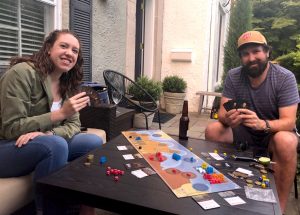
It has taken Kevin Bertram several years to put the game The Shores of Tripoli together. The time was not wasted, as the game is interesting and easy to follow, once one gets accustomed to the rules. If this is truly the first game created by Fort Circle Games, then there are going to be great things coming. Enjoy the experience!
(As an Amazon Associate, JAR earns from qualifying purchases. This helps toward providing our content free of charge.)





Recent Articles
Lt. Elijah Evans of Maryland: Unresolved Promotion in an Extra Continental Regiment
A Journey North: Jefferson, Madison, and the Forging of a Friendship
New Jersey’s Revolutionary Rivalry
Recent Comments
"The Evolution of the..."
This article is a gem. Sparkling. Excellent research. Wide and deep. Thank...
"The Evolution of the..."
A very interesting article, thank you! A more general question, if you...
"The Evolution of the..."
Thoroughly researched and a succinct presentation, especially given the article's breadth.